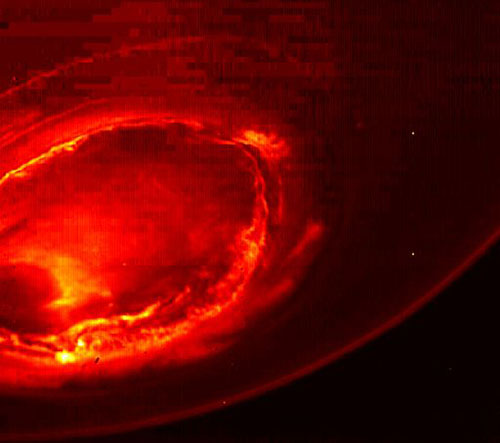|

September 06, 2016
from
SpaceWeather Website
On August 27, for the first time ever, NASA's Juno spacecraft
swooped over Jupiter's south pole.
The flyby revealed an astonishing vortex
of infra-red light:

"While we knew that the flyby of
Jupiter's south pole might reveal the planet's southern aurora,
we were still amazed to see it for the first time," says Alberto
Adriani from the Istituto di Astrofisica e Planetologia Spaziali
in Rome.
Alberto Adriani is a
co-investigator on the Jovian Infrared Auroral Mapper (JIRAM),
the instrument that took the picture.
Another instrument on Juno named "Waves" detected low-frequency
(<100 kHz) radio signals coming from Jupiter's aurora-zone. To make
these signals audible, mission scientists at the University of Iowa
shifted the signals into the frequency range of human hearing.
The audio begins about 30 seconds into
this movie:
Thirteen hours of radio emissions from Jupiter's intense auroras are
presented here, both visually and in sound.
The data was collected
when the spacecraft made its first orbital pass of the gas giant on
Aug 27, 2016, with all spacecraft instruments turned on.
The
frequency range of these signals is from 7 to 140 kilohertz. Radio
astronomers call these "kilometric emissions" because their
wavelengths are about a kilometer long.
If the auroras of Jupiter sound mysterious
- that's because they are.
Unlike Earth, which lights up in response to solar activity, Jupiter
makes its own auroras. The power source is the giant planet's own
rotation. Although Jupiter is ten times wider than Earth, it manages
to spin around 2.5 times as fast as our little planet.
As any
freshman engineering student knows, if you spin a magnet you've got
an electric generator. And Jupiter is a very big magnet. Induced
electric fields accelerate particles toward Jupiter's poles where
the aurora action takes place.
Remarkably, many of the particles
that rain down on Jupiter's poles appear to be ejecta from volcanoes
on Io. How this complicated system actually works is a puzzle.
|


